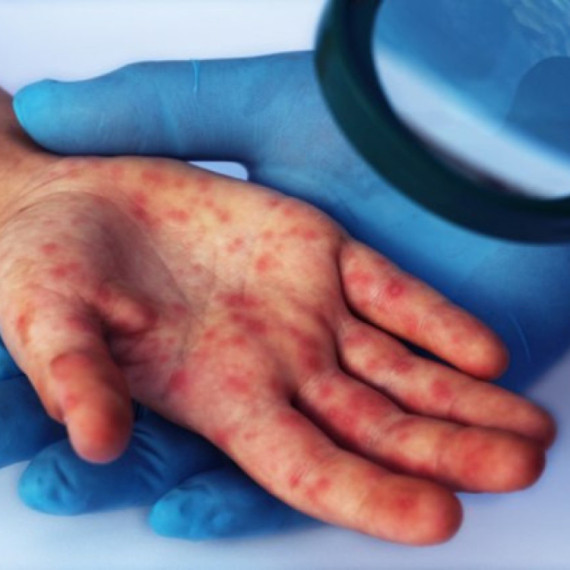Dairy farmers to be supplied with uncontaminated corn
The Ministry of Agriculture has asked for corn from state reserves to be given to dairy farmers who currently feed their cattle with contaminated fodder.
Thursday, 21.02.2013.
20:42

BELGRADE The Ministry of Agriculture has asked for corn from state reserves to be given to dairy farmers who currently feed their cattle with contaminated fodder. This is one of the measures that the authorities are undertaking in order to solve the problem of aflatoxin contaminated milk. Dairy farmers to be supplied with uncontaminated corn The government has also been asked to give the farmers "compounds" that will lower the cancerogenic substance's presence in the contaminated corn. The ministry said on Thursday they were confident that the government will act quickly on their requests. Nenad Budimirovic of the Serbian Chamber of Commerce (PKS) believes that the crisis "could be over within days" if these solutions were implemented. He also said he expected no long-term consequences for the milk and dairy industry, "if steps are taken in a timely manner", and added: "We are now putting out a fire, it will be put out, and this is only about milk. We cannot detect any aflatoxin in processed milk and yogurt and cheeses because the technological process of their (production) destroys much of aflatoxin, lowering its levels below those prescribed by the rules." The crisis, however, could bring down corn prices, but this expert does not expect any "great turbulence" in the milk market. (sxc.hu, stock) Working group advises testing animal feed too The Serbian Ministry of Agriculture working group for aflatoxin monitoring recommended on Thursday that the milk quality tests include animal feed and that the feed containing mycotoxin B1 in illegal quantities be removed from the dairy cows' diet. The Vojvodina Secretariat for Agriculture posted on its website on Thursday that the working group had also suggested adding mycotoxin-reducing absorbers to animal feed, introducing unscheduled tests of the milk from sheep and goats, increasing the number of samples tested for the presence of aflatoxin M1, introduction of unscheduled inspections and tests on animal feed as well. It is necessary to use the confirmation method to verify the results received from the screening method, and since no laboratory in the country uses an accredited confirmation method, it is necessary to send the samples to EU laboratories in order to get adequate results, the working group said. The cause of the presence aflatoxin M1 in milk lies in contaminated animal feed, particularly corn, which resulted from last year's drought, the group stated. Besides the drought, which led to kernels cracking, and contamination already present in the fields, large fluctuations in temperature, exceeding 15 degrees Celsius, that were recorded in late 2012 and early 2013 also helped create aflatoxin. To prevent the appearance of aflatoxin M1 in milk, it is necessary to exclude food containing mycotoxin B1 in illegal quantities from the dairy cows' diet and to add absorbers that reduce the absorption of mycotoxin in animals. "Three days after the feed containing aflatoxin B1 is excluded from the diet, mycotoxin M1 stops appearing in milk," the working group noted. Further testing for the presence of aflatoxin in raw milk is necessary and milk containing aflatoxin M1 in higher concentration than 0.05 micrograms per 1 kilogram of milk should be pulled out of production. The working group was established to monitor the situation regarding the presence of aflatoxin in food and animal feed and propose solutions. B92 Tanjug
Dairy farmers to be supplied with uncontaminated corn
The government has also been asked to give the farmers "compounds" that will lower the cancerogenic substance's presence in the contaminated corn.The ministry said on Thursday they were confident that the government will act quickly on their requests.
Nenad Budimirović of the Serbian Chamber of Commerce (PKS) believes that the crisis "could be over within days" if these solutions were implemented.
He also said he expected no long-term consequences for the milk and dairy industry, "if steps are taken in a timely manner", and added:
"We are now putting out a fire, it will be put out, and this is only about milk. We cannot detect any aflatoxin in processed milk and yogurt and cheeses because the technological process of their (production) destroys much of aflatoxin, lowering its levels below those prescribed by the rules."
The crisis, however, could bring down corn prices, but this expert does not expect any "great turbulence" in the milk market.
Working group advises testing animal feed too
The Serbian Ministry of Agriculture working group for aflatoxin monitoring recommended on Thursday that the milk quality tests include animal feed and that the feed containing mycotoxin B1 in illegal quantities be removed from the dairy cows' diet.The Vojvodina Secretariat for Agriculture posted on its website on Thursday that the working group had also suggested adding mycotoxin-reducing absorbers to animal feed, introducing unscheduled tests of the milk from sheep and goats, increasing the number of samples tested for the presence of aflatoxin M1, introduction of unscheduled inspections and tests on animal feed as well.
It is necessary to use the confirmation method to verify the results received from the screening method, and since no laboratory in the country uses an accredited confirmation method, it is necessary to send the samples to EU laboratories in order to get adequate results, the working group said.
The cause of the presence aflatoxin M1 in milk lies in contaminated animal feed, particularly corn, which resulted from last year's drought, the group stated.
Besides the drought, which led to kernels cracking, and contamination already present in the fields, large fluctuations in temperature, exceeding 15 degrees Celsius, that were recorded in late 2012 and early 2013 also helped create aflatoxin.
To prevent the appearance of aflatoxin M1 in milk, it is necessary to exclude food containing mycotoxin B1 in illegal quantities from the dairy cows' diet and to add absorbers that reduce the absorption of mycotoxin in animals.
"Three days after the feed containing aflatoxin B1 is excluded from the diet, mycotoxin M1 stops appearing in milk," the working group noted.
Further testing for the presence of aflatoxin in raw milk is necessary and milk containing aflatoxin M1 in higher concentration than 0.05 micrograms per 1 kilogram of milk should be pulled out of production.
The working group was established to monitor the situation regarding the presence of aflatoxin in food and animal feed and propose solutions.


























































Komentari 2
Pogledaj komentare